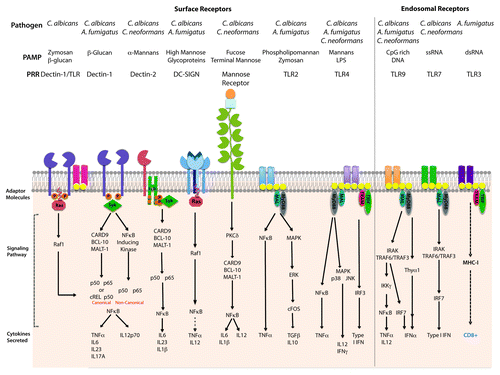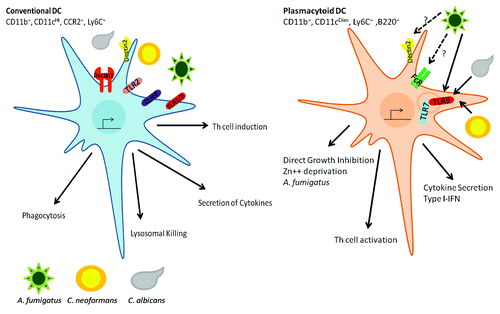Figures & data
Figure 1. Pattern recognition receptors on DCs and signaling pathways that prime T cell differentiation. Recognition of C. neoformans, C. albicans and A. fumigatus mediates by detection of fungal pathogen-associated molecular patterns via Toll-like receptors (TLRs) in the cell surface or endosomes and C-type lectin receptors (CLRs). This graphic represents the TLRs and CLRs responsible for the detection of C. albicans, C. neoformans and A. fumigatus expressed on DCs and the signaling pathways involved in the antifungal response.

Figure 2. DC mediated responses to fungal pathogens. Conventional DCs are characterized by CD11b+, CD11cHI, Ly6CHi and CCR2+. These cDCs express the surface TLRs (TLR1, TLR2, TLR4 and TLR6) and the CLRs (Dectin1, Dectin2 and DC-SIGN). Upon recognition of the fungal pathogen, cDCs activate a series signaling cascades that result in: (1) phagocytosis of the fungal pathogen, (2) uptake to lysosomal compartments where the pathogen is killed and antigens can be loaded into MHC for presentation to T cells, (3) Secretion of cytokines and chemokines responsible for communicating with other cells to induce a host response and (4) induce the proper Th response. pDCs express the endosomal TLRs (TLR7 and TLR9), FcRγ and possibly the CLR Dectin2. pDCs are responsible for: (1) detection of exogenous DNA and RNA resulting in the induction of an inflammatory response, (2) orchestrating Th cell responses and (3) direct killing of A. fumigatus hyphae.
